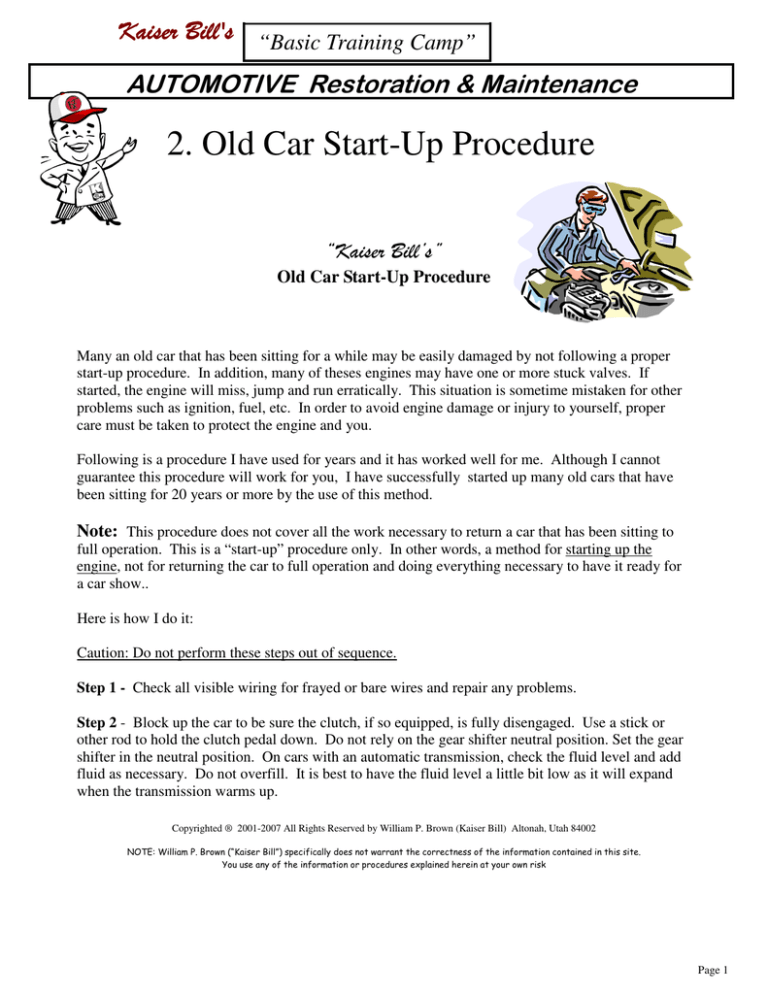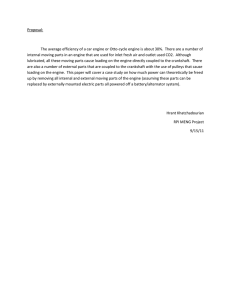
“Basic Training Camp”
2. Old Car Start-Up Procedure
Old Car Start-Up Procedure
Many an old car that has been sitting for a while may be easily damaged by not following a proper
start-up procedure. In addition, many of theses engines may have one or more stuck valves. If
started, the engine will miss, jump and run erratically. This situation is sometime mistaken for other
problems such as ignition, fuel, etc. In order to avoid engine damage or injury to yourself, proper
care must be taken to protect the engine and you.
Following is a procedure I have used for years and it has worked well for me. Although I cannot
guarantee this procedure will work for you, I have successfully started up many old cars that have
been sitting for 20 years or more by the use of this method.
Note: This procedure does not cover all the work necessary to return a car that has been sitting to
full operation. This is a “start-up” procedure only. In other words, a method for starting up the
engine, not for returning the car to full operation and doing everything necessary to have it ready for
a car show..
Here is how I do it:
Caution: Do not perform these steps out of sequence.
Step 1 - Check all visible wiring for frayed or bare wires and repair any problems.
Step 2 - Block up the car to be sure the clutch, if so equipped, is fully disengaged. Use a stick or
other rod to hold the clutch pedal down. Do not rely on the gear shifter neutral position. Set the gear
shifter in the neutral position. On cars with an automatic transmission, check the fluid level and add
fluid as necessary. Do not overfill. It is best to have the fluid level a little bit low as it will expand
when the transmission warms up.
Copyrighted ® 2001-2007 All Rights Reserved by William P. Brown (Kaiser Bill) Altonah, Utah 84002
! ""
"
#
"
$
Page 1
“Basic Training Camp”
2. Old Car Start-Up Procedure, Cont’d
Step 3 - Next remove the old spark plugs. Then put a few heavy squirts of 100% “Marvel oil” into each cylinder through the spark plug hole and turn the engine over several times with the starter. ( A 12-volt battery
jumpered directly to the starter works best. The 12-volts will not damage your starter unless you crank the
engine for an extended period. (First, remove the battery cables from the car battery.) Repeatedly crank the
engine for three or four times after waiting a few minutes between each cranking. Then loosely replace the
old spark plugs and let the engine sit for a few days. Then remove the plugs and turn the engine over several
more times until no oil is being blown out of the spark plug holes. Caution: If you attempt to crank the engine with much oil left in the cylinders and the spark plugs installed, you may bend or break a piston rod.
Step 4 - Change the engine oil to a high-detergent type and change the oil filter, if so equipped. (Note: you
may have heard stories of changing an old engine to the new high-detergent type oil will damage your engine
by breaking loose old deposits of sludge. This author is not aware of any evidence that this actually occurs
and I have changed many old engines over to the newer oils with no problems whatsoever.) Use a light
weight oil for the initial start-up such as 10W-30W or 5W-30W. Do not use a synthetic type oil. Synthetic
oil will prevent the engine from “re-seating” the piston rings.
Step 5 - Check the radiator and water hoses, including those for the heater, for leaks or overly soft spots.
The soft spots may collapse and cut off the coolant flow when you start the car. Replace all suspect hoses
and correct any radiator leaks. Fill the radiator with water only! Use only water until after the initial startup as any head gasket leak will damage the engine if antifreeze gets into the cylinders. After the initial short
run, and engine cool-down, replace the water with 50-50 mix of good quality antifreeze unless there is a sign
of a blown head gasket. The indication is usually a large bubbling of air pressure out of the radiator filler.
Watch for liquid leaking out of the water pump. Small leaks in the cooling system can be tolerated for the
initial start-up and corrected later. Install the radiator cap loosely at the first click.
Step 6 - Check the fan belts and replace those that are extra brittle or frayed. Tighten all belts to the proper
tension.
Step 7 - Check the ignition system, including wires, points, distributor cap, coil and plugs. Note: Install
new set of spark plugs if possible. Be sure to set the proper gap. Old plugs have a habit of not firing good
under compression. I also always install new plug and coil wires.
Step 8 - Set up an external fuel source such as a small fuel tank connected directly to the carburetor through
a filter. Do not attempt to start the car using the old fuel pump and fuel from the gas tank. Many carburetors
have been ruined by old fuel or dirt from the old lines or tank. Fasten the fuel container securely and at a
point slightly higher than the carburetor. Be sure to have an adequate fire extinguisher handy.
Page 2
“Basic Training Camp”
2. Old Car Start-Up Procedure, Cont’d
Step 9 - Pour about 10% per volume of Marvel Oil into your external small fuel container and mix well.
Step 10 - Do not turn on the ignition key. Remove the wire from the BAT side of the coil. Leave the
wire attached to the coil that is connected to the distributor. Connect the proper battery voltage and polarity directly to the BAT side of the coil (Usually a 6 volt battery). Start the engine by applying 12 volts
directly to the starter. Remove the 12 volts immediately when the engine starts. Run the engine for about
three (3) minutes at 1,200 to 1,500 rpm keeping watch for overheating. A hand held laser temperature
gauge is very useful here in case the old temperature gauge is not operating correctly.
Caution: Be sure to do this in a fresh-air environment to avoid asphyxiation - remember, auto exhaust is
extremely dangerous.
Runs Rough? If the engine runs rough, it can be caused by several problems including carburetor, timing, ignition or poor engine compression. First, check the engine compression on each cylinder before the
engine cools down. If one or more cylinders check very low you may have some stuck valves, rusty cylinder walls or stuck piston rings. Stuck valves can usually be determined by taking a compression check
as the valve will be stuck “open.” A cylinder with almost no compression is usually a sign of a stuck
valve, although an extremely badly burnt valve could also be the cause. A cylinder with a burnt valve,
however, will usually have some compression but very low. Try to loosen these by first pouring a small
stream of concentrated mixture of 50% Marvel oil and gasoline directly down the carburetor while the engine is running at around 1200 rpm, being careful not to stall the engine. If this first treatment fails to
break the valve loose repeat the initial “Marvel” oil treatment explained in Step 3 several times before
giving up. Usually they will finally break loose. I have personally never had a Kaiser-Frazer engine that I
could not break the valves loose by this method. If all this fails to you may have a more serious problem
that will require engine disassembly and inspection. If the compression is good, inspect the carburetor,
ignition and timing for the cause.
Step 11. After initially running the engine for about 3 minutes, shut it off. Let the engine cool down for
a few minutes but do not let the engine get completely cool at this point. The engine temperature will
actually increase for a short time as the coolant is no longer being circulated through the engine. This will
put increased pressure on the radiator coolant hoses. During this partial cool-down, check carefully for
leaks and anything that seems abnormal. If all appears to be OK, drain the oil and install fresh oil and
change the oil filter. Use the same type and brand oil as before, but in a heavier 10W-40W or a 20W50W. Do not let the engine cool completely down and re-start it. Let it run at approximately 1,000 to
1,200 rpm for about 5 minutes. During this run, it is a good time to turn the heat on your heater and check
your heater core for leaks.
Step 12. Next let the engine cool down completely, preferably overnight. Then again change the oil and
oil filter, and check all the fluids, radiator, automatic transmission, power steering reservoir, etc. Now,
you should be ready to complete the other work necessary to return the entire car to service.
Page 3

